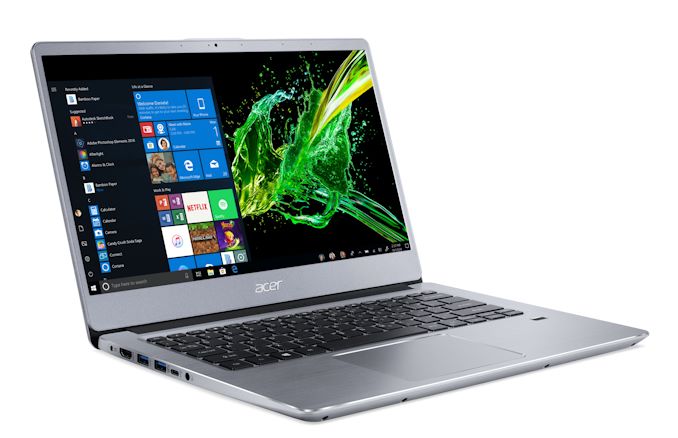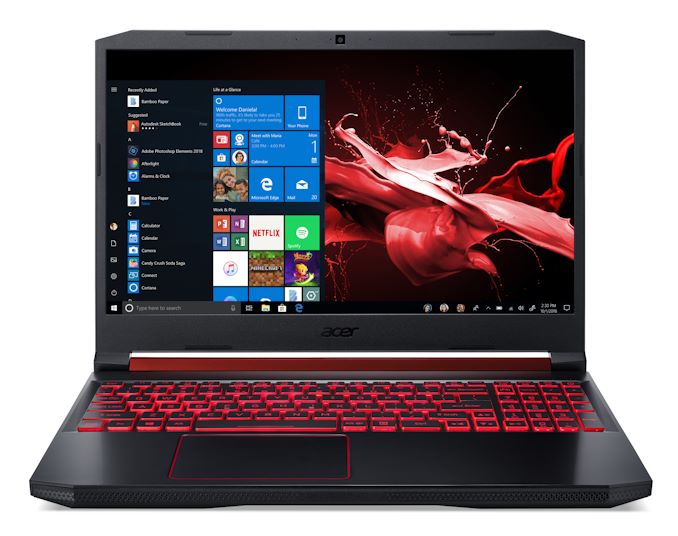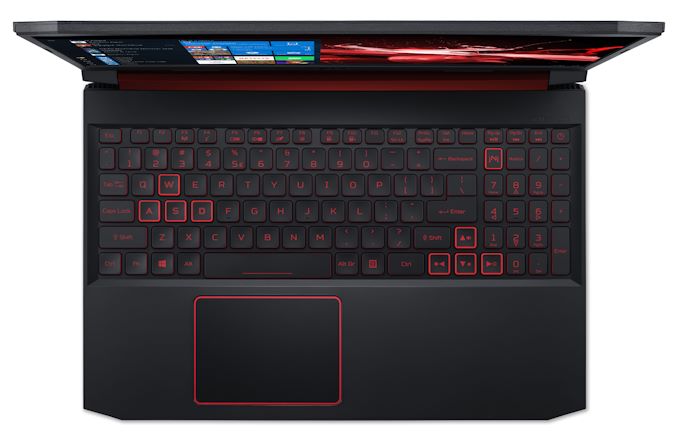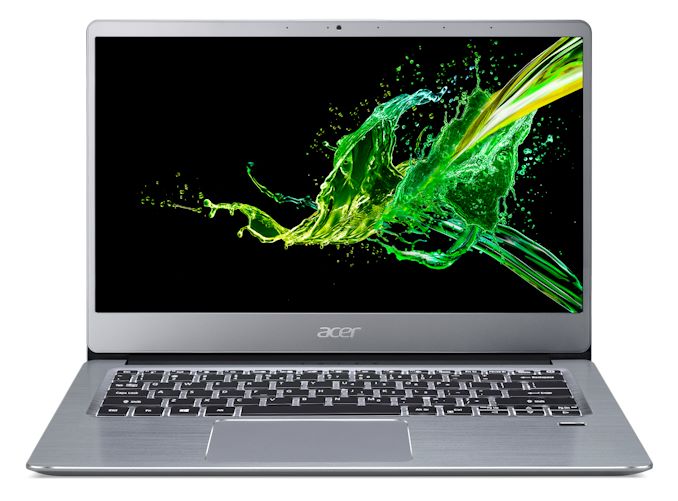Acer Updates Nitro 5 And Swift 3 Laptops With 2nd Gen AMD Ryzen Mobile
by Brett Howse on May 23, 2019 12:40 AM EST
Today Acer is announcing some updates to some of their AMD lineup, with the Acer Nitro 5 gaming laptop and Acer Swift 3 both being refreshed with the latest AMD Ryzen Mobile processors. We’ve taken a look at both the Nitro 5 and Swift 3 previous with the Ryzen 2500U and 2700U processors respectively. The Nitro 5 is a gaming system, and as such comes with a Polaris based GPU as well, but both laptops showcased that AMD has made tremendous strides in performance compared to their previous offerings.
Acer Nitro 5
The updated Nitro 5 will offer up to a 2nd Gen AMD Ryzen 7 3750H, which offers four cores, eight threads, and a 2.3 GHz base clock with a 4 GHz boost. The default TDP is 35 Watts, with a cTDP of between 12 and 35 Watts. The previous Nitro 5 ran its Ryzen 5 2500U in cTDP up mode, which allowed for up to 25 Watts of sustained power draw, so the Ryzen 7 3750H should allow for even higher sustained frequencies thanks to the extra headroom. As a gaming laptop, Acer also sells the Nitro series with a 45-Watt Intel offering, so there’s certainly enough cooling to handle the extra TDP from the new AMD CPU.
The GPU is still the AMD Radeon RX560X, which we found was similar in performance to a GTX 1050 laptop, although in gaming workloads that were more heavily CPU bound, the performance did drop back some. Hopefully with the new Ryzen 7 3750H that will no longer be the case.
Otherwise, the laptop is more or less identical to the previous model. It still offers a 15.6-inch 1920x1080 IPS display, and an appealing design. Acer’s Nitro 5 lineup offers a lot of value for a gaming system, and with these updates internals, that value should be even better. Acer hasn’t announced pricing yet, but it should be in-line with previous model which started at $669.99.
Acer Swift 3
Acer’s 14-inch Swift 3 also gets an upgrade. The CPU gets a bump from the Ryzen 7 2700U to the Ryzen 7 3700U as the top AMD choice. It features the same specifications as the 3750H, with a four-core, eight-thread design, with a 2.3 GHz base clock and 4.0 GHz boost clock. The major difference is the 3700U has a default TDP of 15 Watts, compared to 35 Watts in the H model. It also offers a cTDP of between 12 and 35 Watts, but as an Ultrabook class of notebook, Acer will almost certainly be offering this at the default TDP.
On the GPU side, the new 3700U comes with a Vega 10 by default, with a 1.4 GHz maximum frequency, but Acer is now offering an optional discrete Radeon RX 540X, which is the same Polaris based GPU as the Nitro 5 offers, but cut down from 16 compute units to 8. This may not be a huge performance update compared to the already impressive integrated Vega graphics of the Ryzen 7 3700U, but it should offer at least a small bump if only for not having to share the TDP with the CPU.
The 14-inch panel is IPS at 1920x1080, and will open to 180° if needed. The Swift 3 features an aluminum design that offers a great finish for a not too expensive laptop. As with the Nitro, Acer hasn’t announced pricing at this time, but expect it to be similar to the original Swift 3 which started around $699.99.
Source: Acer














30 Comments
View All Comments
nandnandnand - Thursday, May 23, 2019 - link
12nm Ryzen Mobile is for suckers. Wait for 7nm.deil - Thursday, May 23, 2019 - link
its not. For anyone on intel laptop from 7 gen backward its still a major bump.I agree that next gen will bump the numbers by 30%, but 12nm is plenty powerful compared to standard user needs.
nandnandnand - Thursday, May 23, 2019 - link
It's not just the 20-30% IPC+clock improvement. They could use that opportunity to double the max core count for Ryzen Mobile from 4 to 8. Especially if they are using the same 8-core chiplet used in all the other Zen 2 products.The cherry on top could be AV1 hardware decode support.
Santoval - Thursday, May 23, 2019 - link
It's unclear if Zen 2 based APUs will go directly to 8 cores and if they'll use chiplets. Chiplets might be unsuitable for laptops. More likely they will not use chiplets and they'll move to monolithic 6 cores + Navi iGPU dies. Using 8-core chiplets for laptops would require using the exact same dies as the desktop and *severely* downclocking them, on top of the space and power required for the I/O die. That would collapse single core performance.neblogai - Thursday, May 23, 2019 - link
Chiplets might be a fast way to have 8-core Zen in laptops, but there is yet no indication of AMD doing it. Also, AMD have only 4-core CCX, so monolithic 6-core APU is very unlikely. Old leaked AMD plans, that have been reliable thus far, have next APUs as 7nm 4c/8t, and there were leaks of them using Vega. This would obviously be the low power, mainstream APU to adress 80-90% of laptop market. For really low cost solutions- they have just released 2c/4t die. But for high performance mobile- no info if AMD are planning anything.jeremyshaw - Thursday, May 23, 2019 - link
Yeah, the downside of monolithic dies where major components are developed by completely different teams - it just takes longer to do. Not that chiplets (or MCM, as it was known) is a walk in the park.Some part of me is disappointed that AMD isn't focusing on mobile first, but their top end scaling seems to be working out for them in servers.
Alexvrb - Thursday, May 23, 2019 - link
All indications are that they won't be using a chiplet design for their first 7nm APUs. I'm sure they have their reasons, more space efficient probably (more room for larger iGPU). They'll likely get there eventually but I don't know if it will happen before they end up with a stacking arrangement and/or I/O integral to the interposer.Even setting that aside, 7nm APUs are a ways off. That's why they have a 12nm stopgap. Slightly higher clocks across the board, better temps (mostly due to solder IMO), probably substantially better sustained clocks too. It's still a decent upgrade, and if you're in the market NOW (not 6-9 months from now) they have some good options spanning from 12W to 35W.
Death666Angel - Thursday, May 23, 2019 - link
Sure, so wait another half year to a year? If you can, great. Why not just continue waiting for 5nm or 3nm?nandnandnand - Thursday, May 23, 2019 - link
Intel has 6 and 8-core mobile chips. When AMD puts those out, they are worth a buy.tokyojerry - Thursday, May 23, 2019 - link
That's true. It makes sense to me unless one wants to get a good bargain for only $700 USD versus north of 2K. Money-savings is the key here.